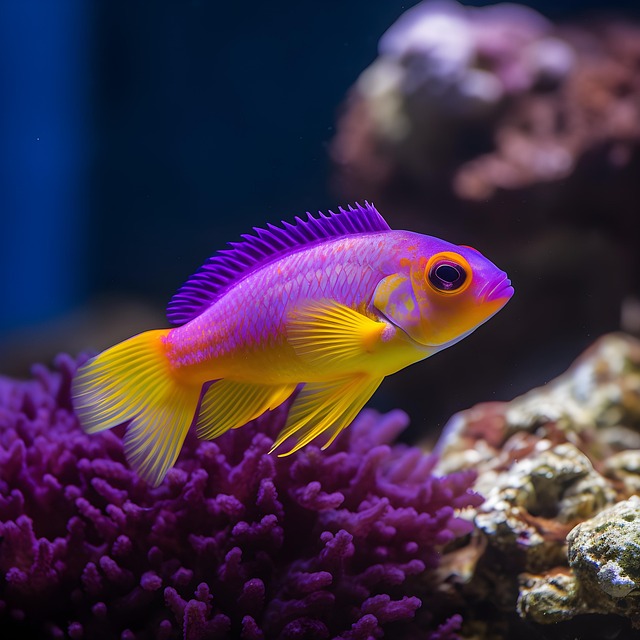Designing specialized enclosures for exotic sharks and rays as aquarium attractions requires a balance between recreation of natural habitats and ensuring welfare. Key elements include spacious areas with appropriate currents, diverse zones for rest, feeding, and exploration, deep pools, cave-like structures, vegetation mimicry, advanced filtration, water quality monitoring, strategic feeding stations, hiding spots, and minimal stress. These enclosures transform aquariums into immersive, educational displays, promoting well-being while offering visitors captivating aquarium attractions. Ethical design focuses on habitat replication, stimulation, social structures, and transparent communication with stakeholders.
Discover the world of specialized enclosures designed for sharks, rays, and exotic species, transforming traditional aquariums into vibrant, educational aquarium attractions. This comprehensive guide explores key aspects such as designing habitats that promote shark and ray welfare, understanding the unique needs of exotic species, and enhancing visitor experiences through innovative displays. We also delve into ethical considerations surrounding these captivating yet complex creatures.
Designing Enclosures for Shark and Ray Welfare
Designing enclosures for sharks and rays involves a careful balance between creating an environment that mimics their natural habitat and ensuring their welfare. These marine giants require spacious, well-oxygenated spaces with appropriate currents to replicate the ocean’s conditions. One key aspect is incorporating diverse zones within the enclosure, allowing for rest, feeding, and exploration. For instance, incorporating deep pools, cave-like structures, and vegetation mimicry can provide both safety and stimulation.
Aquarium attractions go beyond aesthetics; they must consider the physiological needs of these species. Proper filtration systems, water quality monitoring, and regular maintenance are essential to maintaining a healthy environment. Additionally, strategic placement of feeding stations and hiding spots caters to their natural behaviors, promoting well-being and reducing stress. By integrating these design principles, aquariums can offer visitors a captivating glimpse into the underwater world while also providing optimal care for sharks and rays.
Exotic Species: Unique Housing Requirements
Exotic species, including sharks and rays, bring a unique dynamic to aquariums, serving as stunning aquarium attractions. However, their housing requires specialized enclosures that cater to their specific needs. These creatures often inhabit diverse ecosystems with varying water temperatures, currents, and habitats, necessitating tailored environments for optimal well-being.
Compared to more common species, exotic sharks and rays may need larger tanks with intricate designs to replicate their natural habitats accurately. Some require strong currents to mimic open ocean conditions, while others thrive in calmer waters. Enclosures must also consider water quality, filtration systems, and lighting to create a balanced environment that meets the unique physiological requirements of each species. This level of customization ensures these fascinating creatures can be displayed effectively while maintaining their health and longevity within the aquarium setting.
Enhancing Aquarium Experiences: Specialized Displays
Specialized enclosures play a pivotal role in enhancing aquarium experiences, transforming mundane tank displays into captivating and educational aquaria. These designed environments cater to the unique needs of diverse species, from sharks and rays to exotic aquatic creatures. By recreating their natural habitats, aquariums can offer visitors an immersive journey, fostering a deeper connection with these often misunderstood marine life forms.
Through innovative design and advanced technology, specialized displays create dynamic aquarium attractions. From large-scale recirculating systems mimicking the open ocean to intricate replicas of coral reefs, these exhibits provide optimal conditions for the well-being of the animals while captivating audiences. The use of lighting, filtration, and temperature control systems ensures a balanced ecosystem, allowing visitors to observe these magnificent creatures in a way that closely resembles their natural habitats.
Navigating Ethical Considerations in Exotics Enclosures
Navigating ethical considerations is paramount when designing specialized enclosures for exotic species like sharks and rays. While these creatures captivate visitors as iconic aquarium attractions, their welfare must be at the forefront. Ethical concerns arise from the need to replicate their natural habitats accurately, ensuring physical and mental stimulation, and providing appropriate social structures.
Enclosure design should aim to minimize stress and promote natural behaviors. This involves careful consideration of space allocation, water quality, temperature control, and the introduction of hiding spots and vertical dimensions. Moreover, maintaining transparent communication with stakeholders, including conservation experts and the public, fosters transparency and builds trust in the ethical management of these fascinating species within aquatic exhibits.
Specialized enclosures play a pivotal role in enhancing aquarium experiences, ensuring the welfare of sharks, rays, and exotic species, while also navigating ethical considerations. By designing thoughtful habitats that meet unique physiological needs, aquariums can provide remarkable displays that captivate audiences and foster a deeper appreciation for these fascinating creatures. Integrating these specialized designs strategically contributes to the overall success of aquarium attractions, creating memorable experiences that resonate with visitors worldwide.
